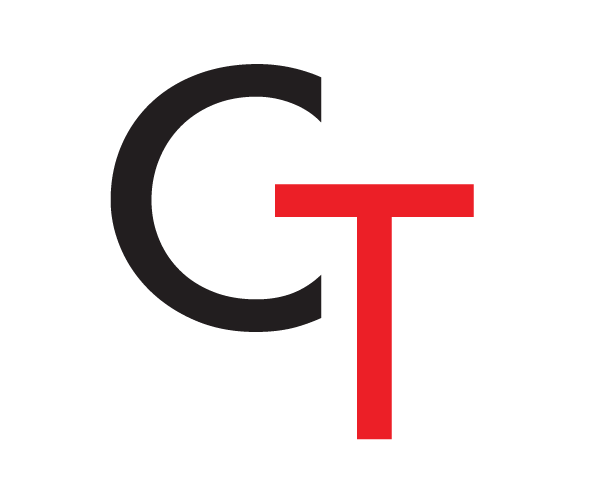Unfortunately, my plague of injury has taken yet another turn and I'm now facing even longer off court due to constant lower back pain (that I've had for around six weeks now).
Apologies for burdening you all with yet another injury update, but, lower back pain is very common among squash players and indeed in everyday life too, so, perhaps some of the information I share this week will be helpful or at least relatable to some of you.
I'll go through a brief summary and update on my previous ankle injury, then I'll talk about my new injury and the opposing opinions I've heard from professionals.
Then, just to make sure I'm not moaning too much about myself (and so you can actually gain something from this article), I'll also be going through some great back exercises that have been helping the pain and tightness (as well as my flexibility).
An Update On My Ankle
So, in case you hadn't read my previous newsletters about my ankle injury, I sustained a grade 3 ligament tear after rolling it at the start of the summer on a trail run with some friends.
That was my first proper injury in my entire squash life and it certainly wasn't a fun experience.
I had extensive physiotherapy to stay on top of to reduce swelling, regain my range of motion, and eventually get back into doing load-bearing exercises to strengthen it back up again.
Right now, I'd say my ankle is almost back to normal. I'm not quite sure it'll ever be fully back to normal but it no longer stops me from doing anything, it's just pretty swollen and my range of motion isn't quite what it used to be.
I definitely learned a lot from the experience and gained a newfound understanding for how much disruption an injury can cause to everyday life as well as being able to play squash and exercise in general.
And this ankle injury, in the grand scheme of things, wasn't even severe in comparison to injuries that other squash players have experienced.
I know I need to be careful in the future since the likelihood of me rolling it again is significantly higher. I'm still keeping up with my rehabilitation exercises to keep ankle strength up, especially since I'm back off the squash court due to a new problem.
My New Injury
As you can probably imagine, I was keen to get back on the squash court since I'd had four or five months off due to the ankle injury.
I hit lightly with friends a couple of times and things were starting to feel back to normal with my movement and changes of direction, however, I unfortunately took it one step too far.
I woke up one day with quite a sore back around 6 weeks ago. The pain was in my lower left back and it just felt as though I'd slept in a strange position.
I had some training booked with a friend that evening followed by some doubles with another couple of friends after.
My back was getting more and more painful in that first training session, even though we were just doing light drills like length rallies and volleying with feeds.
You might feel the same about this, but, when on court, I feel as though pain is suppressed a little bit since you're so focused on training or the match at hand.
I think it was a combination of that, and me being stubborn about playing squash again following so long off with the ankle injury, that made me push through the pain and carry on playing.
After the session, my lower back was throbbing and felt pretty tight, but I also went on to play doubles, telling myself that doubles isn't too harsh on the body and I would be fine.
In hindsight, that was certainly not a wise decision.
The following few days after that, my lower left back was in a lot of pain. It hurt when I was in bed (whenever I tried to turn over) and also when I was walking (when I lifted my left leg in particular).
I just assumed it would be overused and rested it for the following week or so.
The pain did die down a lot, however, it kind of plateaued after that. I had a physio session booked that I was planning on cancelling since my ankle was pretty much fine, however, I decided to go anyway and see if she could help with my back.
Originally, she also thought that I'd just pushed a little too hard on the squash court and pulled something, so she did some sports massaging and gave me some lower back and glute exercises to do to loosen it up a bit.
However, over the following weeks, a few things changed...
Doctor vs Physiotherapist Opinions
A couple of weeks after the physio visit, nothing had changed, I was still experiencing constant back pain when walking and when doing other motions (such as standing up after sitting down for a while).
I feel like I'm perhaps making it sound worse than it is, I'll just clarify that the pain isn't hugely extreme, it's just constant.
Anyway, I managed to speak to my GP about the problem and they prescribed me some strong anti-inflammatory painkillers and told me to try to get onto the NHS' physio scheme that will eventually (after a heck of a lot of waiting by the sounds of it) will get me booked in for a scan.
The GP said that she thought it was sciatica and I would most likely just have to wait longer, however, she also mentioned that if I get any numbness in my legs I need to go to A&E straight away as it can be a sign of Cauda Equina Syndrome (CES) which is pretty dangerous if not treated straight away.
A week after my chat with the GP, the painkillers hadn't done much and I was starting to experience numbness in my foot and up my left leg, so I went to A&E just to be on the safe side.
CES is very rare but, after a thoroughly enjoyable 6-hour wait in A&E on a Sunday afternoon and evening, the doctor I spoke to ruled it out but told me I did the right thing by coming in.
This doctor also told me that she thought it was sciatica or a herniated disc after asking about 40 different questions related to different symptoms of lower back issues off the top of her head (her knowledge was certainly impressive).
After some Googling of symptoms etc I decided to go back to my physio and get her opinion too.
This brings me right up to last night (I'm writing this on 11/01/2024), after doing a bunch of motions and some deep pressure relief (as well as a brisk walk around the block), my physiotherapist said that she's pretty sure it's not a herniated disc or sciatica, instead, she thinks it's something joint-related.
She gave me some pretty good reasoning for this including the fact that I should be in a lot more pain when doing certain motions, which made a lot of sense.
My dad has suffered from sciatica in the past and he said it was incredibly painful.
The physiotherapist instead seems confident that I'm suffering from sacroiliac joint dysfunction (SIJ dysfunction), which is essentially just abnormal motion in the sacroiliac joint (either too much motion or too little motion).
It's hard to tell what caused this, it seems like it's a mixture of things. Overdoing it on the day I played squash definitely didn't help, however, my back was already hurting prior to that.
My physio said that this could be due to the fact I went from consistently running and playing squash almost every day to completely stopping (when I injured my ankle), meaning that all these muscles I used so regularly have tightened up.
Apparently my glutes and lower back were both incredibly tight, which perhaps explained why the physio visit was so painful!
Anyway, SIJ is a pretty common issue so I'm really really hoping that this is the problem so I can start actually fixing it. From what I've read, it's kind of like a cross section between a bunch of different areas of your body so exercises that help this involve the hips, the pelvis, the core, as well as the lower back.
It's certainly difficult to navigate when I have doctors telling me one thing (that it's bone or nerve related) and physiotherapists telling me another (that it's joint related).
Based on the reasoning I got from the physio, I think I'm leaning towards her opinion being the correct one. I don't think I'm in enough pain for this to be a slipped disc or something like that.
But, only time will tell I guess.
At the end of the session, the physio taped up my back which has made it a little less painful to walk on and now I'm getting started on doing the exercise that she's allocated for me...
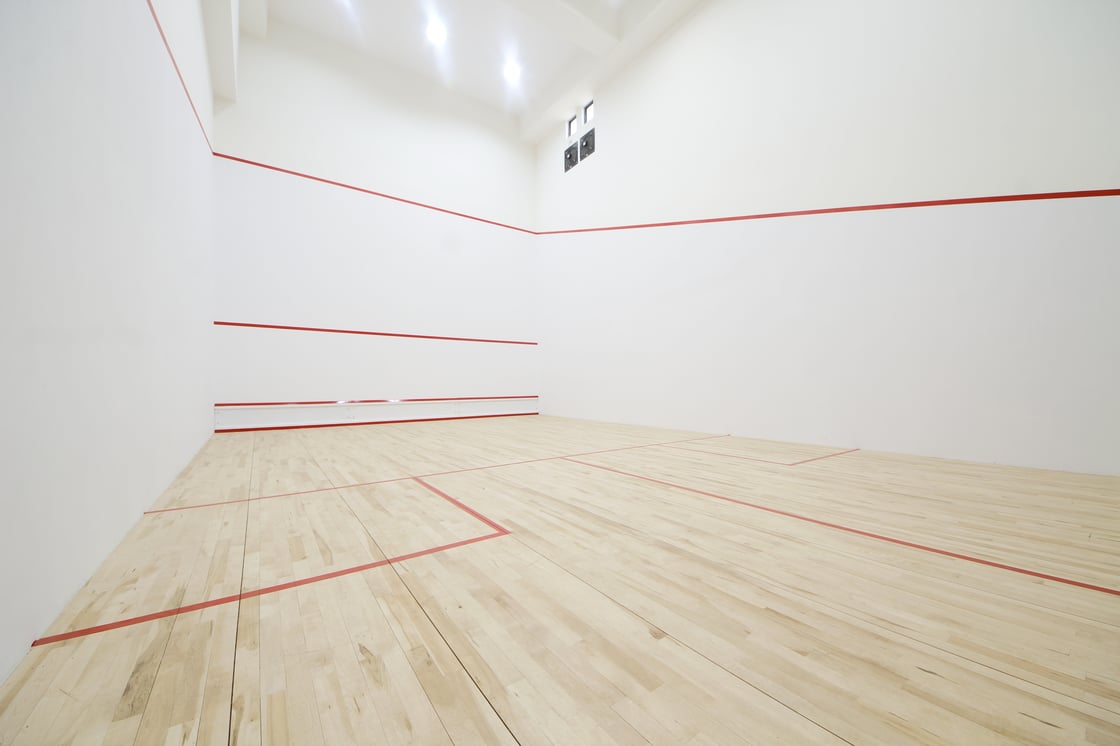
Lower Back Exercises
One thing I absolutely love about the physiotherapist that I visit is that they have an app that they use to provide personalised rehab exercises to patients.
I have to log it on the app every time I do my exercises (every day) and rate how difficult or painful each exercises was. My physio sees this so it makes me accountable for sticking to my rehabilitation which I really like.
Anyway, below are some of the best exercises that she's given me to do (she gave me 12 in total). I've only gone through this routine once so far, however, there were a few that really stuck out as helping my back pain, so I'll include those six below...
TA activation, alt. hip flex.
Lie on your back with your knees bent and your back in neutral position (slightly arched). Engage your core by recruiting your pelvic floor and transverse abdominis. Maintain a steady abdominal breathing while you lift one leg up to 90 degrees-at the hip-and keep the knee bent. Lower the foot down as you lift the other leg. Alternate the legs. Keep your back and pelvis completely still at all times.
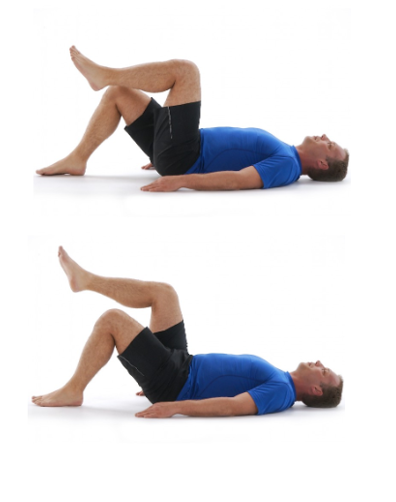
Figure 4 stretch on wall
Lie on your back with your knees bent, place the affected-side foot over the opposite knee and the unaffected-side foot flat on the wall with the leg bent to 90 degrees. Maintain the position and relax. Push on your knee to increase the stretch.
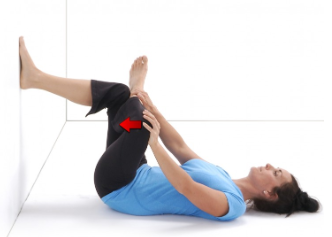
Spine curl w/band
Start in crook lying. Lift yourself up, peeling one vertebra at a time until your thighs are about on a straight line with your torso.Lower yourself on the floor doing the reverse motion of putting down one vertebra on the ground at a time. Do not lift the head off the floor.
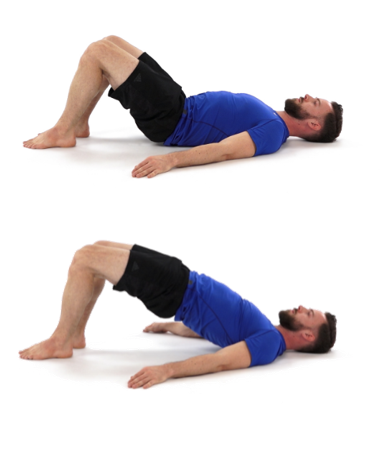
Gluteus maximus stretch
Lie down on your back and grab the left knee with the left hand and pull it toward the opposite shoulder. Grab the shin with the right hand and pull lightly to gently rotate the leg. Keep the body relaxed. You should feel the stretch in your left buttock. Repeat with other leg.
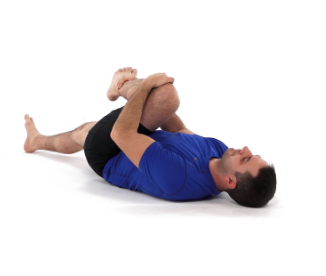
Hip flexors stretch (static) - right side > left
Kneel on one knee creating a 90° angle with the opposite hip and use a chair for support. Tilt your pelvis backwards to flatten your lower back and transfer your weight forward until you feel a gentle stretch on the anterior aspect of your hip of the lower leg. Maintain the position and relax. Maintain your upper body upright and your lower back flat (not arched).
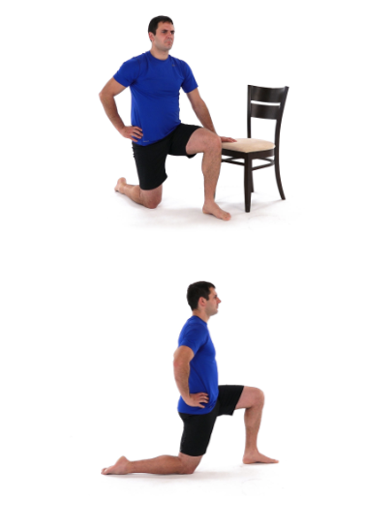
Four point uni. hip ext.
Get on your hands and knees (four point position) with your knees and hands, hip and shoulders width apart. Your back is in a neutral position (slightly arched). Activate your lower abdominals. Maintain steady abdominal breathing. Lift one leg backwards, keeping your back in a neutral position. Return to the initial position and repeat with the other leg.
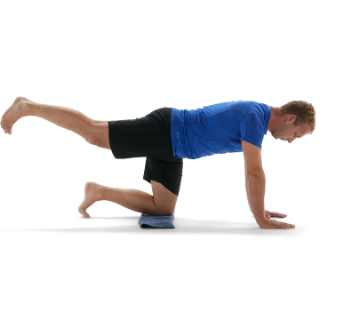
My Advice For Anyone Else Suffering From A Lower Back Injury
Hopefully, the above exercises might be beneficial to some of you. From what I've read, even if you're not suffering from a back injury, these types of exercises are great for maintaining your back strength and health.
I'm pretty sure most squash players experience tightness in their lower back after touch matches and training sessions so those exercises are a great way to relieve those feelings.
I'm trying hard not to sound as though I'm a professional here, I'm just trying to relay the information I've been given by professionals.
I'm definitely not an expert in dealing with this injury, however, I'm learning a lot about the process so hopefully I can help some of you if you're struggling with a similar issue.
From what I've been told by physiotherapists and doctors, these types of back injuries are notorious for taking a long time to heal. It's taken me some time to come to terms with this.
The back injury has been much more of a mental struggle than the ankle injury, however, I think this is due to the fact I'd only just got back on the court after 6 months and now I'm back to not being able to play yet again.
Since this just came at the start of the season, I'm also now missing important team matches and tournaments, plus, my cardio will definitely be taking a hit.
Despite receiving conflicting information, speaking to professionals (especially the physiotherapist) has put my mind at ease. So, if you are lucky enough to be in a position to visit the physio, get their opinion, and get some deep tissue massages done in the process, I'd highly advise doing so.
The not-knowing element is definitely the worst part of this injury as I've got no clue how long I'm going to be out for. My ankle injury was improving bit by bit every day and results were much more tangible, this back injury plays on my mind every day as it seems to get worse and better without anything specifically affecting it.
As someone who always needs to be busy, I've thrown myself into my work a little bit more and I've been hitting the gym almost every morning (of course, while being very careful not to do anything that impacts my back).
The gym has been a great escape so far and it's enjoyable to be learning and improving something new. Plus, I can do my rehab at the gym as well.
So, while I can't give a heck of a lot of professional advice, I'd highly recommend finding another avenue to expend your energy, whether that's in something like reading, walking (if you can), going to the gym, or trying out any other new hobby.
Also, if you're struggling with an ongoing injury, just know that I've spoken to many other squash players who are (or have been) in the same boat, so you should know that you're definitely not alone.
If you're struggling with something similar, please feel free to reach out, I'd be happy to chat about it and we can share experiences! You might also have some advice for me...
Anyway, hopefully this week's newsletter hasn't been too depressing and that it's possibly helped some of you, I promise I'll cover something lighter in my next article!
This article was taken from our On The 'T' Newsletter, if you're interested in receiving more content like this, please feel free to sign up using the subscribe section located at the bottom left of this page (or underneath the article if you're on mobile), thanks!
